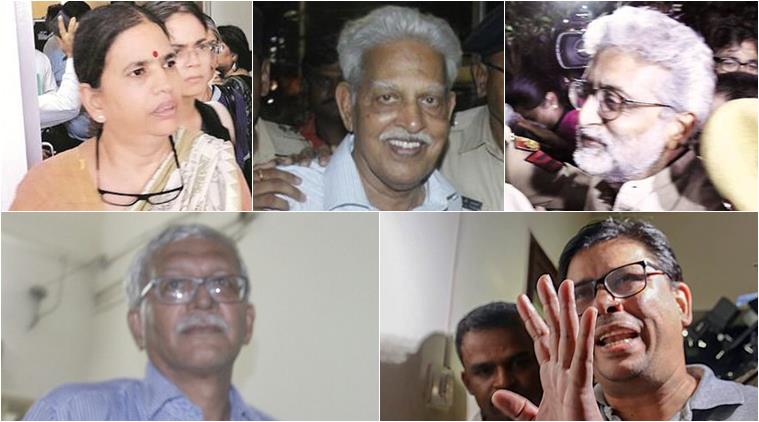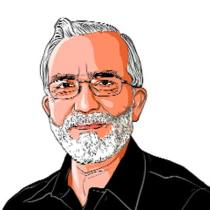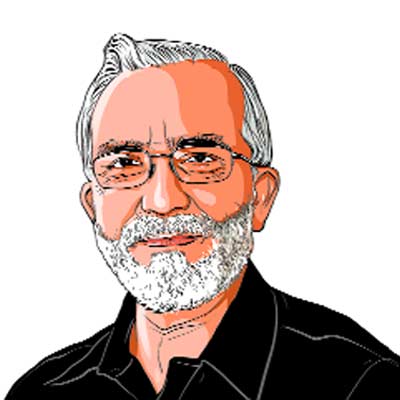The urban Naxal subterfuge
Such naming is meant to suppress dissent. It erases the distinction between disagreement and violence.

When the state begins to take itself too seriously, it begins to suspect all dissent.
Labelling helps in defining — and possibly maligning — your opponents. It also helps obfuscate the issues or, at any rate, distract public attention. The latest label to be employed in India’s public sphere, “urban Maoist” (or its more famous version, “urban Naxal”), is no exception. So much so that when Girish Karnad recently sported a placard, “Me too Urban Naxal”, a lawyer filed a complaint against him stating that urban Naxals are those who spread insurgency. The lawyer is also reported to have requested the Bengaluru police to “interrogate Karnad about Bhima-Koregaon violence” (Financial Express, September 7). Joe McCarthy must be rejoicing in his grave.
When the state begins to take itself too seriously, it begins to suspect all dissent. The US had its moment of paranoia over dissent when it named a House committee the Committee on Un-American activities during the brief but dreaded McCarthy era. India seems to be prey to paranoia repeatedly, in fits of concern over national security. As the case challenging the police action against five persons accused of being involved in a Maoist conspiracy is pending with the Supreme Court, two things stare us in the eye: The debate on the arrests narrowly is focused on the virtue (or vice) of those accused; and there is an absence of more general public outcry. Both these underline the relative success of the strategy of “labelling to malign”. For the last few years, we have become far too sensitive as a nation to care for a distinction between dissent or a principled stand and a threat to security. If urban Maoist is today’s label, anti-national was a label popularised only yesterday. And if one were following social media, the re-mix of anti-India, anti-Hindu, Naxal and Muslim-Christian conspiracy would be easily perceptible as the folklore of popular prejudice produced through labelling.
But the episode arising out of the five arrests has two other pertinent dimensions. One relates to the approach of the Indian state to organised political violence. What has come to be conveniently named (labelling yet again) as terrorism, requires a more nuanced naming and taming. Whether of the Maoist or the secessionist variety, the politics behind such organised activities cannot be ignored. Unfortunately, the Indian state has consistently chosen to reduce these to mere law and order questions. This approach allows the state to keep barricading itself with more stringent legislation, assigning power to the executive.
It would also be well to remember that political parties across the spectrum are enamoured with the instrumentality of harsh legislation. The tension between such legislation and fundamental rights is often lost on politicians and parties. If the BJP is using UAPA, it was the previous government that actually strengthened this 1967 law. And if the UPA amended the UAPA, the NDA got POTA passed. Not only do parties not have a principled stand on “anti-terror” laws, they use existing laws indiscriminately. It is this unstated — and sometimes clearly stated — consensus in the political, bureaucratic and police establishment that gives sustenance to not merely allegedly arbitrary arrests but also to the labelling industry. Because, unless you label someone as anti-India, as terrorists, as persons wanting to divide India, as conspiring to create disaffection against India and so on, executive excesses cannot be sold to the public.
The currently disputed arrests are situated in the UAPA. If the Court’s observation invoking the now-famous pressure cooker analogy is to be logically extended, then the Court has its task cut out. Rather than restricting itself to the scrutiny of executive action, it would be necessary to scrutinise the law itself. Such a scrutiny will, of course, have limited traction. Incidence of encircling the judiciary with a non-complying public opinion are on the rise and in this case too, far too many Indians would support the political class in the effort to firewall judicial intervention with claims to the democratic wisdom of the legislature. Nevertheless, the judiciary would need to undertake the unpleasant task of confronting public and political prejudice against dissent.
This takes us to the second worrisome dimension of the controversy. It is about the tension between a democratic state and the repressive turn that states are often wont to take. The history of democracy is a continuous battle against this repressive urge. Employing the democratic paraphernalia, modern politics seeks to contain the collective urge of repression that the state so eloquently represents. But this continuous effort to democratise the state is countered by numerous challenges that bring back demands for effective regulation with a heavy hand. India is no exception. Democracy requires that the regulatory apparatus remains within the limits of the rule of law. It further demands that law is not merely a regulation imposed by the legislature, but it also means reasonableness, restraint and respect for dissent.
The history of post-Independence rule of law in India shows how weak we have been in this respect. The journey of Indian state is dotted with many blackspots but fundamentally, there was an influence of two factors in our state design. The first was the post-Partition chaos that was exacerbated by the dissolution of princely states. That traumatic moment accompanying freedom seemed to justify provisions and practices that were in contravention to the rule of law — or at least provisions that stretched legal credulity to the limit. It is a matter of deep concern that we never revisited those provisions and practices. Instead, the Indian state went on identifying excuses to perpetuate them. Even after the Emergency, we did not seriously redesign the relationship between freedoms and reasonable restrictions.
Two, because the state design was allowed to harbour restrictions on freedoms, there was too much emphasis on the wisdom and good-naturedness of the ruling class. The rulers — both the politicians and the bureaucrats — were burdened with the responsibility of not using the law arbitrarily or excessively. That burden was far too much to tolerate and the executive often transgressed expectations.
In this backdrop, policymakers and academics lazily adopted the umbrella term terrorism as the convenient justification for strengthening state regulation against dissent. This meant that we lost our ability to make a nuanced distinction between different forms of organised political violence; we chose to ignore that many acts of terrorism were deeply political; and once we succumbed to the idea that terrorism needs a strong state response alone, we began losing the distinction between wanton violence and dissent.
We have now arrived at a juncture when distasteful or disliked dissent is sought to be suppressed through legal subterfuge and clever naming. No wonder, the UAPA and labels such as anti-national and urban Naxal are glibly employed by a regime that seeks to become overbearing both in law and the sphere of ideas.
The writer is co-director, Lokniti programme and editor of Studies in Indian Politics.
For all the latest Opinion News, download Indian Express App
More From Suhas Palshikar
- The new reservationIt is not a demand for social justice but proportional power-sharing that underlies the new quota agitations..
- Don’t hold your noseCongress needs to frame a cogent stand on coalitions rather than looking at them merely as tactical necessity ..
- Two speeches, a spectacleAt Nagpur, Pranab Mukherjee lost an opportunity. Mohan Bhagwat seized it ..







































No hay comentarios:
Publicar un comentario